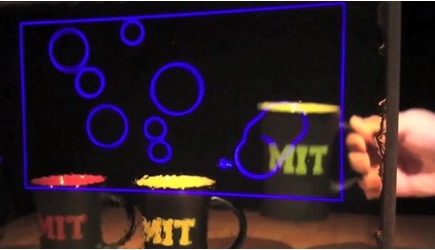MIT Turns Windows into Transparent Information Displays
January 31, 2014
on
on

Researchers of the Massachusetts Institute of Technology have a working prototype of a low-cost and scalable transparent display system.
A person today is exposed to as much information in a week as somebody in 18th century was in their entire life. However, there is a great divergence between refresh rate of information in our physical environment and that of our connected devices. The latter give access to an endless stream of information while the former is still mostly occupied by static displays communicating a single message. As long information is locked into dedicated devices, we'll be tethered to them. If we are to liberate ourselves from the machines, information dissemination has to break from the bounds of our hand-held screens and flow freely in the world around us.
Moving forward to data-enrich ALL THE THINGS professors Marin Soljačić and John Joannopoulos of MIT are working on a system that displays information on transparent surfaces.
What is special about the system is that there aren't any embedded electronics in the display. It's simply a thin transparent foil applied to a glass surface making it easy and cheap to install. The information is beamed on the surface with a laser projector creating a sharp image whilst maintaining the transparency of the window.
To create this effect the Soljačić, Joannopoulos and their colleagues used silver nanoparticles. The 60 nanometer wide particles can be manipulated to scatter a specific wavelength of the visible light spectrum while all other waves pass through. In the demonstration video the MIT guys have the particles reflect blue light, presenting the observer with sharp blue patterns on an otherwise clear screen.
The MIT setup is still in its prototype phase. The images are monochromatic but Soljačić and co are confident it is possible to create full color displays. Also, the nanoparticles embedded in foil can be manufactured at large scale and low cost, creating a full color, low-cost, scalable transparent display system.
The findings were published in the journal Nature Communications [paywalled].
Image: MIT
A person today is exposed to as much information in a week as somebody in 18th century was in their entire life. However, there is a great divergence between refresh rate of information in our physical environment and that of our connected devices. The latter give access to an endless stream of information while the former is still mostly occupied by static displays communicating a single message. As long information is locked into dedicated devices, we'll be tethered to them. If we are to liberate ourselves from the machines, information dissemination has to break from the bounds of our hand-held screens and flow freely in the world around us.
Moving forward to data-enrich ALL THE THINGS professors Marin Soljačić and John Joannopoulos of MIT are working on a system that displays information on transparent surfaces.
What is special about the system is that there aren't any embedded electronics in the display. It's simply a thin transparent foil applied to a glass surface making it easy and cheap to install. The information is beamed on the surface with a laser projector creating a sharp image whilst maintaining the transparency of the window.
To create this effect the Soljačić, Joannopoulos and their colleagues used silver nanoparticles. The 60 nanometer wide particles can be manipulated to scatter a specific wavelength of the visible light spectrum while all other waves pass through. In the demonstration video the MIT guys have the particles reflect blue light, presenting the observer with sharp blue patterns on an otherwise clear screen.
The MIT setup is still in its prototype phase. The images are monochromatic but Soljačić and co are confident it is possible to create full color displays. Also, the nanoparticles embedded in foil can be manufactured at large scale and low cost, creating a full color, low-cost, scalable transparent display system.
The findings were published in the journal Nature Communications [paywalled].
Image: MIT
Read full article
Hide full article


Discussion (1 comment)